- Staffing
- Design New
The need for human connection is a biological and social imperative; loneliness is a warning signal to satisfy that need by seeking out other human beings.
- Fostering Interaction
- Engaging Participants
- Marketing
Beyond Child Care
SECTION 10
By failing to prepare, you are preparing to fail.
– Benjamin Franklin
With a growing recognition of the value of intergenerational engagement in combatting ageism, reducing social isolation, and building sustainable communities, there is increased attention in the United States and around the world to the concept of shared sites. Although currently the majority of intergenerational shared sites involve young children interacting with older adults, the potential to engage other age groups in shared care, shared learning, and shared living is limitless.
This final section of the Toolkit highlights a variety of models that connect older adults with school-aged children, college students, and young adults in one location. Though they differ in focus, these shared sites are all intentional about creating space and time for intergenerational interaction. They are designed to include both structured and unstructured opportunities to build meaningful relationships, foster mutual learning, and enhance well-being.

10.1 The Intergenerational School, Cleveland, Ohio
10.2 Lasell University-based Retirement Community, Newton, Massachusetts
10.3 Hebrew SeniorLife & the Rashi School, Dedham, Massachusetts
10.4 Bridge Meadows, Portland, Oregon
10.5 Intergenerational Housing and Community Services, Alicante, Spain
10.6 Humanitas, Deventer, The Netherlands
10.7 Los Angeles LGBT Center, Los Angeles, California
10.1 The Intergenerational School, Cleveland, Ohio

In 2000, the first Intergenerational School, founded by Peter and Cathy Whitehouse, opened in Cleveland, OH. It was structured around the ideology that people of all ages can learn alongside one another throughout the lifespan. Planned activities and flexible meetings were used to facilitate the exchange of generational knowledge, experience, and skills. There are now 3 Intergenerational Schools in Cleveland, all of which are designed to simultaneously increase academic skills and build meaningful cross—generational relationships.
In each of these schools, students are placed in multi-age classrooms based on individual learning needs. Recognizing the importance of relationships in the learning process and the need for additional student support, the founders started a signature reading program called Learning Partners. The partners are mostly retired local citizens age 60 and over, representing a variety of cultural and professional backgrounds. They commit to at least two hours per week with students for one-on-one reading, sharing stories and building relationships.
The training for learning partners emphasizes the need to build a relationship with students through a shared experience around books. The goal is to create an equal relationship where the child is an equal partner and not just a recipient. An Intergenerational Coordinator in each school touches base with volunteers and is responsible for community outreach. In addition to preparing the older adults, the school also explicitly teaches the children about aging and how to engage with older people. Children learn what it means if a person is frail, hard of hearing, or experiencing memory challenges and how to adjust their own behavior accordingly.
This success of Learning Partners led to the development of other intergenerational learning programs such as oral history projects, gardening, drama, music and dance, chess, computers, investing, knitting as well as a variety of community service projects. Some activities take place at assisted care facilities, enabling residents with less mobility to engage in intergenerational learning. Regardless of the specific activity, the core requirements remain the same: relationship-based, interactive requiring the active participation and input from both members of the partnership, and joyful.
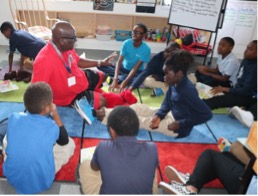
The physical design of the Intergenerational Schools is intended to promote informal as well as formal cross-age interaction. Spaces are designed to function as living rooms or family rooms rather than as traditional classrooms. Hallways have comfortable couches or chairs, small nooks and crannies are available for people to read together, and rooms are filled with book-cases and tables for intergenerational engagement. Moveable panels in some niches allow subdividing the space. The space has good natural light and is wheelchair accessible for older mentors with mobility and/or visual challenges.
10.2 Lasell University-based Retirement Community, Newton, Massachusetts
University-based retirement communities are a growing housing option for older adults in the United States. Housing communities that are built on or near college campuses provide a wealth of opportunities to promote social connectedness across ages. In 2000, Lasell Village, a continuing care retirement community of 225 residents in Newton, MA, was built by Lasell University on the edge of its campus. Its 13 buildings are adjacent to dormitories and academic buildings. Residents are required to complete 450 hours of learning, fitness, and cultural activities, and/or volunteering each year. Five intergenerational courses which focus on reciprocal sharing of experiences are offered each semester in addition to a wide variety of other courses.
Lasell has been intentional about creating classroom environments that are conducive to lifelong learning and intergenerational exchange. Small classrooms and ceiling microphones make it easier for students to hear each other and interact with faculty. Due to generational differences in motivation, skills and experience, faculty members have developed a variety strategies that draw upon diverse perspectives to enrich learnings. Often they meet with older students before a course begins to discuss expectations and practices. They also create opportunities to address age stereotypes by framing age discussion around “us, as we age” rather than young versus old comparisons and building in time for one to one interactions between younger and older students. A Talk of the Ages speaker series and a variety of 2 week modules were created to provide opportunities for students to explore topics of mutual interest.


10.3 Hebrew SeniorLife & the Rashi School, Dedham, Massachusetts
Hebrew SeniorLife (HSL) based in, Roslindale, MA, is a nonprofit, non-sectarian provider of health care and housing for older adults in the Boston area. The organization serves more than 3,000 older adults each day and reaches over 700 students, interns, medical residents and fellows in various geriatric disciplines through research and teaching. HSL programming focuses heavily on social justice, and on respecting and promoting elder independence. Since 2012, the organization’s staff members have been connecting older adults with students to create meaningful learning experiences. Each year HSL implements multigenerational programming fueled by over 75 community partnerships that equally benefit residents and youth.
 HSL’s community in Dedham, MA, is an example of an intentional intergenerational campus. Co-located on 162 acres, NewBridge on the Charles Senior Living and the Rashi School, a K-8 Jewish day school, have a long- standing partnership that is committed to promoting cross-age interaction. Although an internal road separates the school from the housing units, linking the two communities are paved walking paths and an intergenerational sculpture. The paths facilitate regular visits between school-age children and senior housing residents. The NewBridge Community Center, located in the middle of the campus, is the site of many events and has a café that is open to teachers, families of residents, and the broader community. Recently, children and residents worked together to beautify an underground parking garage that connects residents to the Community Center. The mural of outdoor scenes and art panels have made this a more welcoming space.
HSL’s community in Dedham, MA, is an example of an intentional intergenerational campus. Co-located on 162 acres, NewBridge on the Charles Senior Living and the Rashi School, a K-8 Jewish day school, have a long- standing partnership that is committed to promoting cross-age interaction. Although an internal road separates the school from the housing units, linking the two communities are paved walking paths and an intergenerational sculpture. The paths facilitate regular visits between school-age children and senior housing residents. The NewBridge Community Center, located in the middle of the campus, is the site of many events and has a café that is open to teachers, families of residents, and the broader community. Recently, children and residents worked together to beautify an underground parking garage that connects residents to the Community Center. The mural of outdoor scenes and art panels have made this a more welcoming space.
Programs most often take place in large, communal indoor spaces or directly on residential floors and households. Youth are engaged in a variety of programs, including Mitzvah Makers, a monthly after-school program in which 1st-4th grade students visit seniors in long-term care for themed art projects, music, and shared holiday celebration. Making Memories, a middle school program now in its eleventh year, trains and supports students for a series of visits to seniors in memory care. In addition, residents from Independent Living have opportunities to volunteer in classrooms on a regular basis, and students at all grade levels visit NewBridge for holiday-based engagement, guided reading and music programs, and classroom projects, such as a 3rd grade immigration program in which students interview NewBridge residents and staff about their immigration experiences
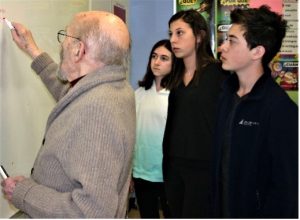
Since the COVID-19 pandemic, HSL has reimagined the range of programming that fuels the NewBridge/Rashi connection. For example, Mitzvah Makers has been redesigned for a virtual format. Students are responsible for creating monthly videos around specific themes (e.g., recipe sharing, nature walks) which are then shared with residents. Middle school students now participate in Making Memories as a video-based program, in addition to writing warm, friendly notes that NewBridge include with the meals delivered to residents. Holidays are brightened by collaborative, remote craft projects and virtual events. Even during physical separation, NewBridge seniors continue to share in the learning and energy of the school day. Residents virtually join Rashi classrooms to read books, engage with student presentations, and participate in dialogue with student leaders.
10.4 Bridge Meadows, Portland, Oregon
Bridge Meadows is an intentional intergenerational community that provides support to youth formerly in foster care and their adoptive families as well as meaningful engagement for older adults. The formation and sustaining of caring relationships is at the core of Bridge Meadows’s two communities in Oregon. Currently there are 150 people living in 18 family homes and 59 apartments for low-income older adults at two sites, one in Portland, and one in Beaverton. This number will grow to 230 when a new campus is opened in Redmond, Oregon.
is an intentional intergenerational community that provides support to youth formerly in foster care and their adoptive families as well as meaningful engagement for older adults. The formation and sustaining of caring relationships is at the core of Bridge Meadows’s two communities in Oregon. Currently there are 150 people living in 18 family homes and 59 apartments for low-income older adults at two sites, one in Portland, and one in Beaverton. This number will grow to 230 when a new campus is opened in Redmond, Oregon.
The older adults who live at Bridge Meadows are over 55 and qualify for affordable housing. They agree to contribute approximately 100 hours of service per quarter to support their neighbors in a variety of ways. Some provide rides to doctor appointments, teach activity classes, or stock the building’s library. Most are involved with the youth by tutoring after school, offering art lessons, or babysitting while parents work, run errands, or take a break. As the functionality of older adults changes, the activities in which they participate may also change.
A Community Support Specialist at each site conducts weekly groups, called “circles,” in order to provide a space for residents to talk about issues they are facing. Additional targeted support groups include a wisdom circle for older residents and a parents’ group for adoptive parents. Bridge Meadows also offers trainings in trauma-informed care to help elders understand how to build relationships with youth. This intentional community benefits everyone—youth enjoy stable homes, parents receive support and guidance, and elders have an opportunity to make a meaningful difference in the lives of families and children.
In addition to Bridge Meadows, there are a handful of other examples of intentional communities that are designed to address a specific social need. These include Hope Meadows in Rantoul, Illinois, the Genesis community in Washington, DC, and Juliette Fowler Communities in the metro Dallas, Texas area.
10.5 Intergenerational Housing and Community Services, Alicante, Spain
 In 2003, the Municipal Housing Board of Alicante, Spain initiated an innovative intergenerational housing model that addresses the housing needs of low-income older adults and young people. Funding was obtained from government and provide sources. Today there are 244 affordable housing units at three different sites owned by the municipality. Seventy eight percent (78%) of residents are over 65 years and 22 % are under 35 years. Preference is given to those elders who are most disadvantaged. Young people are selected based on income as well as personal characteristics (e.g., empathy, motivation) and experience in community work.
In 2003, the Municipal Housing Board of Alicante, Spain initiated an innovative intergenerational housing model that addresses the housing needs of low-income older adults and young people. Funding was obtained from government and provide sources. Today there are 244 affordable housing units at three different sites owned by the municipality. Seventy eight percent (78%) of residents are over 65 years and 22 % are under 35 years. Preference is given to those elders who are most disadvantaged. Young people are selected based on income as well as personal characteristics (e.g., empathy, motivation) and experience in community work.
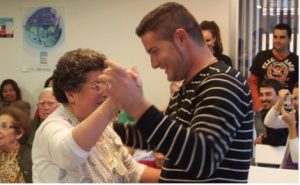 Young people in this housing setting are each responsible for supporting four older adults. They spend a few hours each week engaging in a range of daily, neighborly activities that are managed by residents. Older residents are actively involved in planning and implementing programs and play an active role in governance. Four intergenerational committees were created to oversee programming in the following areas: landscaping and gardening, life stories, community celebrations and technology.
Young people in this housing setting are each responsible for supporting four older adults. They spend a few hours each week engaging in a range of daily, neighborly activities that are managed by residents. Older residents are actively involved in planning and implementing programs and play an active role in governance. Four intergenerational committees were created to oversee programming in the following areas: landscaping and gardening, life stories, community celebrations and technology.
In addition to housing units, this model includes a health care center, public car park and day center that are open to area residents. The housing in environmentally friendly, using locally-sourced materials, solar panels and roof gardens. Rental income is sufficient to cover mortgage payments.
This model provides accessible, affordable housing to multiple age groups and creates a family-like environment that promotes a sense of intergenerational connectedness. Part of its success is selecting the right young people as well as taking the time to understand the aspirations, skills, and concerns of older adults.
10.6 Humanitas, Deventer, The Netherlands
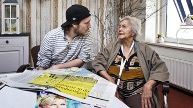
The Humanitas retirement community in Deventer, the Netherlands, is home to six university students and 160 older adults. Humanitas is based on a simple premise: students need affordable housing, older people living in retirement homes need more social connections. In 2012, many cities in the Netherlands were unable to provide housing for thousands of students. Student housing was and continues to be limited, expensive, and cramped. At the same time, the Dutch government was cutting care funding for people over 80 without an urgent care need. Fewer people applied to live in retirement homes, resulting in some empty rooms. Many of the residents in these facilities were lonely and depressed.
The Director of Humanitas recognized the need to transition to a new kind of living environment that would increase connection between residents and the outside world. She saw a win- win for both populations- students could rent a free room in exchange for being a good neighbor, and older people would benefit from being in a home-like environment with young adults.
The students pay no rent in exchange for 30 hours of volunteering. Students organize some meals, play games, go shopping and just “hang out” with older residents. They also help residents with their computers, tablets, and smart phones. The focus is on building relationships and reciprocity. Humanitas also opens its doors to others in the community. A group of children with autism built a train set in the basement of the building and community residents can enjoy the garden. In an effort to be even more inclusive, Humanitas offers free, temporary and emergency support to residents in a nearby neighborhood who have a disability or chronic illness.
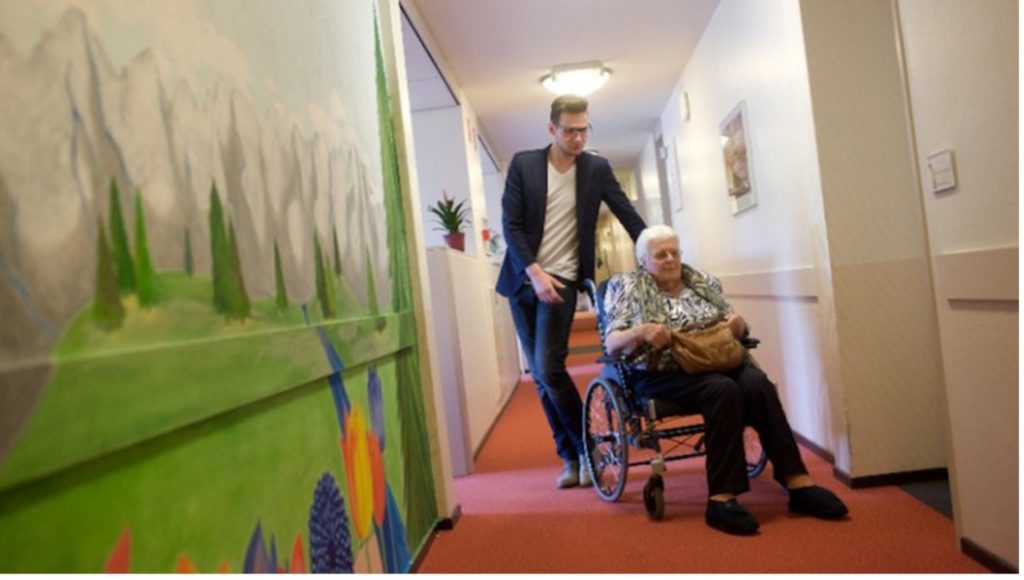
10.7 Los Angeles LGBT Center, Los Angeles, California
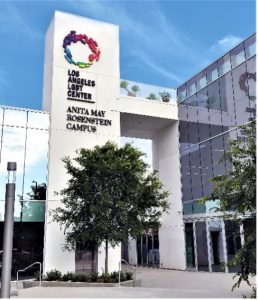 An innovative intergenerational shared site that addresses the needs of LGBTQ homeless youth and older adults opened its doors in 2019 in Los Angeles, CA. The first facility of its kind, the $140 million Anita May Rosenstein Campus includes Emergency and Transitional Housing for LGBTQ youth experiencing homelessness, a new Senior Center, Youth Drop-In Center, and The Ariadne Getty Foundation Youth Academy. In Phase 2 of this ambitious project, 25 supportive housing apartments for LGBTQ youth, ages 18-24, and 97 units of affordable housing for LGBTQ seniors will be opened for occupancy in 2021. The Campus represents a new type of social infrastructure for the LGBTQ community that combines social services and affordable housing in one location. A series of internal courtyards create safe spaces on the Campus, while a public plaza invites the community and the city to connect.
An innovative intergenerational shared site that addresses the needs of LGBTQ homeless youth and older adults opened its doors in 2019 in Los Angeles, CA. The first facility of its kind, the $140 million Anita May Rosenstein Campus includes Emergency and Transitional Housing for LGBTQ youth experiencing homelessness, a new Senior Center, Youth Drop-In Center, and The Ariadne Getty Foundation Youth Academy. In Phase 2 of this ambitious project, 25 supportive housing apartments for LGBTQ youth, ages 18-24, and 97 units of affordable housing for LGBTQ seniors will be opened for occupancy in 2021. The Campus represents a new type of social infrastructure for the LGBTQ community that combines social services and affordable housing in one location. A series of internal courtyards create safe spaces on the Campus, while a public plaza invites the community and the city to connect.
In addition to providing housing and social services, the Center has created an innovative, intergenerational Culinary Arts training program for LGBTQ youth experiencing homelessness and low-income seniors. Taught in the commercial kitchen on the new Campus, the 300-hour program engages older adults from the Center’s Senior Services programs to learn basic culinary skills alongside youth working to exit homelessness. Participants finish the program by completing a 100-hour internship with local restaurants, catering companies, and other food service businesses. The program is designed to not only teach culinary skills but also to bridge the divide between LGBTQ youth and older adults.
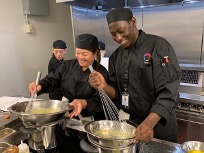 During the pandemic, Culinary Arts trainees have been providing 450 meals per day to the Center’s seniors and youth and helped to create a Pride Pantry which distributes boxes of fresh food and staples to locations throughout Los Angeles. The Center also opened Liberation Coffee House, a social enterprise on the Campus where youth and seniors receive workforce training experience.
During the pandemic, Culinary Arts trainees have been providing 450 meals per day to the Center’s seniors and youth and helped to create a Pride Pantry which distributes boxes of fresh food and staples to locations throughout Los Angeles. The Center also opened Liberation Coffee House, a social enterprise on the Campus where youth and seniors receive workforce training experience.
Through these opportunities, both generations have come together to support each other through challenging times and to celebrate each other’s successes.



